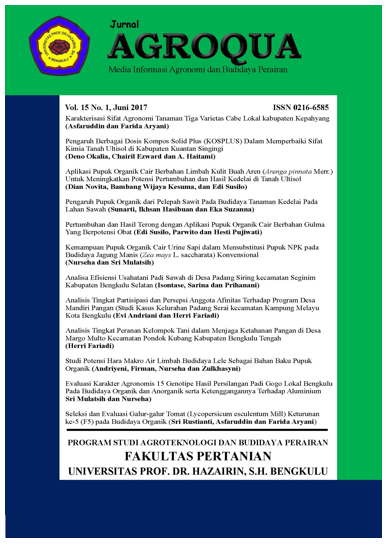UJI TINGKAT KONTAMINASI EKSPLAN ANGGREK Bromheadia finlysoniana L.miq DALAM KULTUR IN-VITRO DENGAN PENAMBAHAN EKSTRAK TOMAT
DOI:
https://doi.org/10.32663/ja.v18i2.1502Keywords:
Orchids, Bacteria, Fungi, Contamination, Tissue CultureAbstract
Bromheadia finlaysoniana L. Miq orchid, is a ground orchid whose population is threatened with extinction due to various human activities, so it needs to be reproduced using tissue culture. The purpose of this study was to determine the level of contamination in various types of explants and administration of tomato extract. The treatment used consisted of two factors, namely the combination of various types of explants and tomato extract, each of which consisted of several levels. The treatment of the first factor was the concentration of explants consisting of 4 types: seeds, leaves, stems and roots, each of which was combined with Tomato Extract at 4 levels: 0, 100 g / L, 200 g / L, and 300 g / L. Observation of the percentage of contamination showed that the best explants for tissue culture propagation of Bromheadia finlaysoniana L. Miq were seed and root explants with a contamination percentage of 36.81% and 37.50%. Observations for the percentage of fungal contamination parameters showed that single explants, with the best treatment were root explants with a contamination percentage of 17.36%. Meanwhile, the best treatment combination was found in root and seed explants without tomato extract, with a percentage of fungal contamination of 8.33%. Observations for the percentage of bacterial contamination, the best single explant treatment was stem explants, with a bacterial contamination percentage of 29.17%. Meanwhile, for the contamination treatment, the best treatment was found in seed and stem explants without giving tomato extract with a percentage of fungal contamination of 16.67%
References
Downloads
Published
Issue
Section
License
Authors who publish with this journal agree to the following terms:
- Authors grant the journal right of first publication with the work simultaneously licensed under a Creative Commons Attribution 4.0 Internasional (CC BY 4.0) Licence that allows others to use and share the work with an acknowledgment of the work's authorship and initial publication in this journal.
- The author(s) still hold the copyright of his/her/their work and retain publishing rights without restrictions such as (but not limited to) patent right, lecture, book and reproduce the article for own purposes.
















